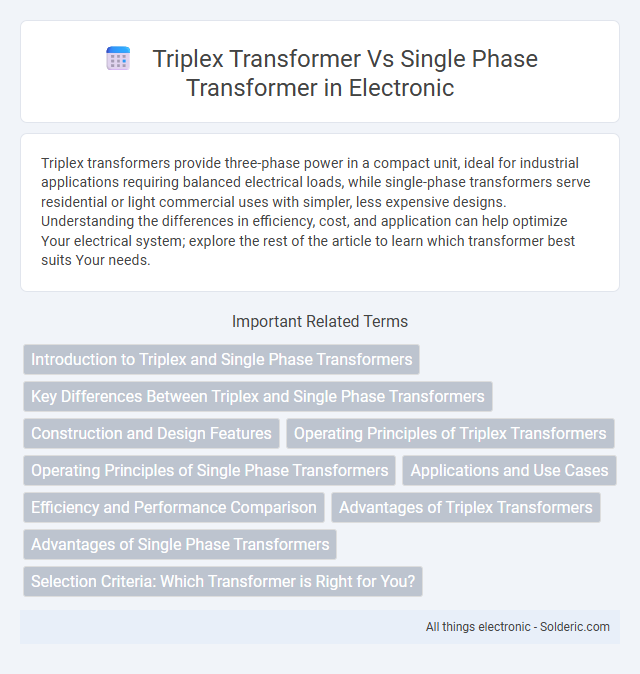Triplex transformers provide three-phase power in a compact unit, ideal for industrial applications requiring balanced electrical loads, while single-phase transformers serve residential or light commercial uses with simpler, less expensive designs. Understanding the differences in efficiency, cost, and application can help optimize Your electrical system; explore the rest of the article to learn which transformer best suits Your needs.
Comparison Table
| Feature | Triplex Transformer | Single Phase Transformer |
|---|---|---|
| Phase | Three phases combined in one unit | Single phase only |
| Application | Industrial and large commercial power distribution | Residential and light commercial power supply |
| Efficiency | Higher efficiency for three-phase loads | Efficient for single-phase loads |
| Size | Compact for three-phase system integration | Smaller size for single-phase usage |
| Cost | Higher initial cost due to complexity | Lower cost for basic applications |
| Installation | Requires three-phase power setup | Simple installation for single-phase circuits |
| Load Handling | Handles balanced and unbalanced three-phase loads | Designed for single-phase loads only |
Introduction to Triplex and Single Phase Transformers
Triplex transformers are specialized units designed to provide three distinct secondary voltages from a single primary source, enhancing versatility in power distribution systems. Single phase transformers, commonly used for residential and light commercial applications, convert voltage between two single-phase circuits to supply consistent voltage levels. Understanding the differences in construction and application helps optimize your electrical setup for efficiency and reliability.
Key Differences Between Triplex and Single Phase Transformers
Triplex transformers are designed to provide three separate single-phase outputs from a single transformer bank, optimizing power distribution for multi-unit residential or commercial buildings. Single phase transformers deliver power through a single alternating current circuit, suitable for simpler, lower load applications. Unlike single phase transformers, triplex transformers enhance load balancing and improve efficiency by simultaneously managing multiple voltages and phases in one integrated unit.
Construction and Design Features
Triplex transformers feature a three-phase core and windings integrated into a single unit, optimizing space and reducing installation complexity compared to single-phase transformers, which contain only one coil per phase. The construction of triplex transformers includes three sets of primary and secondary windings arranged around a common magnetic core, enabling efficient phase balancing and minimizing losses. Single-phase transformers typically have a simpler design with one magnetic core and a single winding set, making them suitable for lower power applications or where phase conversion is not required.
Operating Principles of Triplex Transformers
Triplex transformers operate by combining three single-phase transformers into one unit, enabling efficient distribution of three-phase power in compact electrical systems. Each winding in a triplex transformer handles a separate phase, maintaining balanced voltage and current across the system for optimal performance. Understanding these operating principles helps you select the appropriate transformer type for applications requiring reliable multi-phase power supply.
Operating Principles of Single Phase Transformers
Single phase transformers operate on the principle of electromagnetic induction, where alternating current in the primary winding generates a magnetic flux in the core, inducing voltage in the secondary winding. The magnetic flux alternates and couples the energy between the primary and secondary coils without direct electrical connection. This simple design suits residential and light commercial power distribution, providing voltage transformation between two circuits with efficiency dependent on core material and winding configuration.
Applications and Use Cases
Triplex transformers are predominantly used in residential distribution systems to deliver three-phase power efficiently to multiple single-phase loads, making them ideal for urban and suburban areas with mixed load demands. Single-phase transformers are commonly found in rural or low-density residential areas where power requirements are minimal and primarily single-phase loads are prevalent. Industrial facilities and commercial buildings prefer triplex transformers for their ability to balance loads and reduce infrastructure costs while single-phase transformers support small-scale applications like street lighting and individual household appliances.
Efficiency and Performance Comparison
Triplex transformers typically offer higher efficiency and improved performance compared to single-phase transformers due to their ability to handle three-phase power with less energy loss and better voltage regulation. Your choice of transformer impacts operational cost, as triplex units reduce heat generation and improve load balancing, leading to longer equipment life and lower maintenance. Single-phase transformers, while simpler and less expensive upfront, often exhibit lower efficiency in heavy or unbalanced loads compared to triplex transformers designed for balanced three-phase systems.
Advantages of Triplex Transformers
Triplex transformers offer enhanced efficiency and space-saving benefits compared to single-phase transformers, making them ideal for applications requiring three-phase power from a single unit. Their ability to provide balanced voltage and current across three phases reduces electrical losses and improves system stability. You gain improved reliability and simplified installation with triplex transformers, especially in industrial and commercial power distribution.
Advantages of Single Phase Transformers
Single phase transformers offer simplicity, cost-effectiveness, and ease of installation, making them ideal for residential and light commercial applications. They provide efficient voltage regulation and require less maintenance compared to triplex transformers, which makes single phase transformers a practical choice for your home or small business power needs. Their compact design and lower initial investment result in reduced operational expenses without compromising performance.
Selection Criteria: Which Transformer is Right for You?
When selecting between a triplex transformer and a single-phase transformer, consider the load requirements and application type. Triplex transformers provide multiple secondary voltages suitable for residential or small commercial use with mixed voltage needs, optimizing space and cost. Single-phase transformers excel in applications requiring a stable single voltage output, making them ideal for straightforward, uniform load demands.
triplex transformer vs single phase transformer Infographic

 solderic.com
solderic.com